Fatal Fires Make History | TechNotes

By Jeffrey M. Hugo, CBO
The Top 20 Deadliest Fires in U.S. History
Changes to model codes and standards often occur after massive fires with large losses of life and injuries. Fires such as the MGM Grand Hotel, Our Lady of the Angels, the Iroquois Theater, and other recent fires, such as the Station Nightclub and Grenfell Tower fires have made lasting impacts upon the code and the fire sprinkler industry.
The list below covers the top 20 deadliest building fires in the United States. While the list goes back to 1811, the fires that impacted the current codes and standards happened all throughout the 20th and 21st century. There were approximately 6,760 deaths attributable to these 20 fires. If the deaths could be translated into current day value of statistical life of $7.5 million per death (per FEMA), it adds up to $50,700,000,000 (fifty billion, seven hundred million dollars).
These figures are mind blowing and they help to justify the life safety and property protection of fire sprinkler systems today. A majority of the buildings listed below were without fire sprinkler systems. The World Trade Center in New York City and the Murrah Federal Building in Oklahoma City were sprinklered; however, the sprinkler systems were damaged and inoperable due to the initial explosions and structural damage to the structures. In parentheses, the NFPA 101 and International Building Code (IBC) occupancy classification is noted.
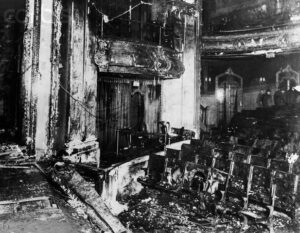 1. World Trade Center– 9/11/2001: Highrise (Business, B)
1. World Trade Center– 9/11/2001: Highrise (Business, B)
NY, NY– 2,749 dead
2. Iroquois Theater– 12/30/1903: Theater (Assembly, A-1)
Chicago, IL – 602 dead
3. Cocoanut Grove – 11/28/1942: Nightclub (Assembly, A-2)
Boston, MA – 492 dead
4. Ohio State Penitentiary – 4/21/1930: Prison (Detention and Correction, I-3)
Columbus, OH – 320 dead
5. Consolidated School – 3/18/1937: School (Educational, E)
New London, TX – 294 dead
6. Conway’s Theater – 12/5/1876: Theater (Assembly, A-1)
Brooklyn, NY – 285 dead
7. Rhythm Club – 4/23/1940: Nightclub (Assembly, A-2)
Natchez, MS – 207 dead
8. Lakeview Grammar School – 3/4/1908: School (Educational, E)
Collinwood, OH – 175 dead
9. Rhodes Opera House – 12/12/1908: Theater (Assembly, A-1)
Boyertown, PA – 170 dead
10. Ringling Brothers Barnum & Bailey Circus – 7/6/1944: Circus (Assembly, A-4)
Hartford, CT – 168 dead
11. Murrah Federal Building – 4/19/1995: Highrise (Business, B)
Oklahoma City, OK – 168 dead
12. Beverly Hills Supper Club – 5/28/1977: Nightclub (Assembly, A-2)
Southgate, KY – 165 dead
13. Richmond Theater – 12/26/1811: Theater (Assembly, A-1)
Richmond, VA – 160 dead
14. Triangle Shirtwaist Company – 3/25/1911: Mercantile (Mercantile, M)
NY, NY – 146 dead
15. Eddystone Ammunition Company – 4/10/1917: Factory (Industrial, F-1)
Eddystone, PA – 133 dead
16. Cleveland Clinic Hospital – 5/15/1929: Hospital (Health Care, I-2)
Cleveland, OH – 125 dead
17. Winecoff Hotel – 12/7/1946: Hotel (Hotel, R-2)
Atlanta, GA – 119 dead
18. Station Nightclub – 2/20/2003: Nightclub (Assembly, A-2)
West Warwick, RI – 100 dead
19. Our Lady of the Angels School – 12/1/1958: School (Educational, E)
Chicago, IL – 95 dead
20. Happy Land Social Club – 3/25/1990: Nightclub (Assembly, A-2)
NY, NY – 87 dead
Cocoanut Grove – Boston, Massachusetts – 1942
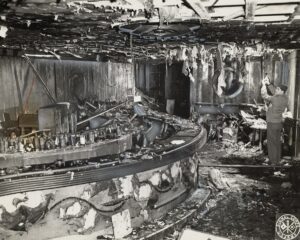
The Cocoanut Grove Fire
The Cocoanut Grove fire occurred at 10:15 pm on the Saturday night of Thanksgiving weekend, November 28, 1942. This nightclub fire had 492 deaths and 130 injuries. A fire started in the basement in the Melody Lounge, igniting the flammable interior finishes, such as the cardboard and paper palm trees and other tropical themed decorations covered in pleather (artificial leather). Overcrowding (430-person occupant load) and lack of exits contributed to the high number of deaths.
The nightclub did have six exits, but the management blocked four of the six to prevent patrons from skipping out on their dinner and bar tab. There were eleven fire extinguishers on site, but no fire sprinklers or fire alarm were installed. Today, codes and standards require fire sprinklers in new assembly occupancies and for existing when the occupant load is 100 or greater. Codes today do not allow revolving doors to serve as an exit (unless sprinklered and the panels collapse in the path of travel), and interior finish rules today would not permit the same decorations used in the club. The club was demolished, and a memorial plaque was installed near the location where multifamily housing is located today.
Our Lady of the Angels – Chicago, Illinois – 1958
The Our Lady of the Angels school (K-8th grade) fire occurred at 2:25 pm on December 1, 1958, on a Monday afternoon after Thanksgiving weekend. The school fire claimed 95 deaths and 77 injuries. A fire started in a basement trash can near the stairwell that served the basement and 1st and 2nd floors. The stairs were unenclosed, meaning the fire had instant access to all three levels, immediately allowing smoke, heat, and the deadly byproducts of fire to spread quickly. The school did not have:
- Fire sprinklers
- Fire-rated enclosed stairways
- Protected vertical openings and shafts
- Fire-rated corridors
The school did have a single fire escape, but the fire in the stairwell and corridor prevented over half of the second-floor students from accessing it. Many students on the second floor, who were trapped by the fire either jumped from a second story window or were incapacitated from the smoke. A manual fire alarm was present, but it was faulty on that day, delaying the fire department response by almost an hour. Schools of that time period did not have fire drills. Codes today require fire drills for all K-12 schools (public, parochial, and private), 1-hour fire-rated stairways and corridors, fire alarm system, and sprinkler systems for new (NFPA 101) or when over 12,000 square feet or 300 occupants (International Building Code). The school was demolished, and a memorial is in place at the site today.
Beverly Hills Supper Club – Southgate, Kentucky – 1977
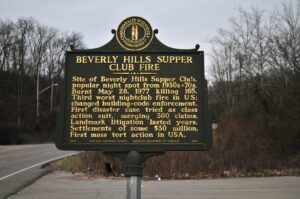
Beverly Hills Supper Club
The Beverly Hills Supper Club fire occurred at 9:00 pm on May 28, 1977, on the Saturday night preceding the Memorial Day holiday. The Supper Club fire, an assembly occupancy, had 165 deaths and over 200 injuries. The fire started in the basement and the cause was deemed either electrical or suspicious in nature. It quickly found its way to the first and second floors through an open spiral staircase.
The estimated 900-1,300 occupants, (600-person occupant load) and the inadequate number of exits contributed to the high number of deaths. Additionally, there was no passive (fire-rated) protection in the corridors and stairs. There were no fire sprinklers or fire alarm present, and the investigation afterward showed a lack of permits and inspections for the several building additions. Today, codes and standards require fire sprinklers in these assembly occupancies when new, or when the occupant load is 100 or greater. The supper club was demolished, and a memorial is in place at the site today.
MGM Grand – Las Vegas, Nevada – 1980
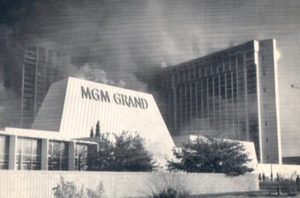
The MGM Grand Fire
The MGM Grand hotel and casino fire occurred at 7:07 am on Friday, November 21, 1980. The hotel and casino fire had 85 deaths and over 700 injuries. An electrical fire started in the first-floor deli and quickly spread through the massive first floor casino area and upwards throughout the 26-floor hotel. Built in 1973, fire sprinklers were not required but were installed in the theater, kitchen, lobby, basement and in the 26th story banquet rooms. Sprinklers were not present in the remaining hotel rooms and a majority of the casino. Where sprinklers were present, it stopped the fire from spreading.
The unprotected or compromised vertical openings, i.e., elevators, stairways, and shafts, and the lack of smoke detection in the HVAC system, allowed the spread of smoke and fire to the upper floors of the hotel. The interior finish consisted of combustible decorations and interior wall framing using combustible materials in a Type I building. Eighty-three of the eighty-five deaths occurred on the upper floors. Ten victims were found in an elevator. This fire and a similar fire in the Las Vegas Hilton that had eight fatalities prompted the State of Nevada to update their codes to sprinkler all buildings open to the public, install smoke detectors in dwelling units and elevator lobbies, plus install hotel maps on the backside of hotel rooms. The hotel reopened fully sprinklered in 1981 and today is the Horseshoe Las Vegas casino.
The Station Nightclub – West Warwick, Rhode Island – 2003
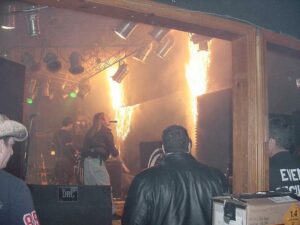
The Station Nightclub Fire
The Station nightclub fire occurred at 11:07 pm on Thursday, February 20, 2003, during a live concert featuring the 1980’s band, Great White. The nightclub fire had 100 deaths and over 230 injuries. The occupant load was 404 and actual attendance was 462. This means that 71% of the occupants either died or suffered an injury. There were no fire sprinklers or fire alarms in the building. The fire started on stage because of the use of live pyrotechnics that ignited the exposed plastic acoustical foam. After the foam ignited, it took roughly a minute for the space to become untenable.
Overcrowding, flammable interior finish, and egress door swing, along with the effects of heat, smoke, and byproducts of combustion, quickly took many lives. This fire changed how buildings and fire codes dealt with nightclubs and bars. The occupant load threshold was reduced from 300 to 100 occupants to trigger fire sprinklers for new construction in the IBC. New assembly nightclub construction in NFPA 101 was required to be sprinkled. NFPA 101 led the way for retrofitting existing assembly with fire sprinklers when the occupant load was over 100. It took until the 2018 International Fire Code (IFC) to require sprinklers in existing A-2 occupancies where 300 or more occupants were consuming alcohol. The Station was demolished, and a memorial is in place at the site today.
Tale of Two High-Rise Fires in 2017
In 2017, the fire protection community saw two high-rise fires occur overseas, both massive fires, with two vastly different outcomes. The Grenfell Tower, a residential high-rise, in the United Kingdom, was 24 stories tall. At 12:54 am, on June 14, 2017, a refrigerator fire started on the fourth floor. The heat from the fire compromised a kitchen window and the fire spread to the outside, quickly igniting the Aluminum Composite Material (ACM), a combustible exterior cladding system that was retrofitted on the exterior. The Grenfell tower did not have fire sprinklers and the mostly exterior fire lasted over sixty hours, with 72 deaths and 70 injuries. The Grenfell Tower is scheduled to be demolished after litigation is completed.
The Marina Torch building, a residential high-rise, in Dubai, UAE, is 86 stories tall. At 1:00 am, on August 4, 2017, a fire was caused by a cigarette in a potted plant on the exterior of the building. Like the Grenfell, the Torch had similar combustible exterior cladding (ACM), but unlike Grenfell, the Torch did have a full fire sprinkler system throughout, with sprinklers extended to the balconies. Unofficial reports claim that over forty sprinklers opened to control the fire that lasted two hours. No one died and there were no injuries. The Torch has had three fires, occurring in 2015, 2017, and 2019. Sprinklers controlled each fire. The Marina Torch is occupied today.
Resources
FEMA Benefit‐Cost Analysis (BCA) Toolkit 6.0 Release Notes
Fatal Fires Make History: Learn How the Codes World Responded to the Deadliest Fires in U.S. History with NFSA’s Tech Tuesday.
Our next Tech Tuesday will be April 16th, 2024, from 12:30 pm to 1:30 pm eastern time. The topic will be Fatal Fires Make History. This course is good for one CEU hour. Register Here.
Model codes and standards are often motivated to change after large fires with large losses of life and injuries. These changes often make an impact to the fire sprinkler industry. Fires such as the MGM Grand Hotel, Our Lady of the Angels, the Iroquois Theater, and other recent fires, such as the Station Nightclub and Grenfell Tower fires make impacts to the industry. This course will detail several large fires and their influence on the industry and their results in the codes and standards being applied today. This course will benefit designers, layout technicians, contractors, as well as code officials to understand the impact of the deadliest fires in U.S. history.
Member Cost: Free
Non-member Cost: $50.00 Learn more about membership.
